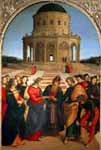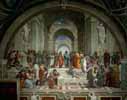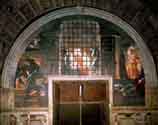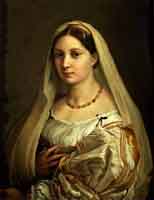Raffaello Sanzio was born on 6th Aprile 1483 in Urbino.
His father, Giovanni Santi, was a painter and encouraged his son to study the works of Piero della Francesca in Urbino (some of his best).
Raffaello started studying drawing techniques and perspectives; as soon as his father noticed his talent he found him a better teacher: Perugino. In this artist’s workshop Raffaello learnt the grace of his works as well as Pinturicchio’s taste for decoration.
At the age of seventeen, Raffaello left Perugino’s with the title of magister, which meant painting was his profession.
In the first period of his career he painted some works in Città di Castello: the altar piece of Beato Nicola da Tolentino (only a few fragments survived and are now in Brescia, Naples and Paris), the banner of Trinity (Civic national Picture Gallery of Città di Castello) and the Crucifixion Mond (London National Gallery). He painted the altarpiece depicting the crowning of the virgin for the Oddi family (Vatican Picture Gallery in Rome).
In those same years he worked with Pinturicchio on the frescos with Scenes of the life of Pius II in the Piccolomini Library of Siena.
In 1504 Raffaello painted one  of his masterpieces: Wedding of the Virgin, now in the Brera Picture Gallery, in Milan. The picture is based on one by Perugino but in this Raffaello achieved a better result than his teacher. In the same year he moved to Florence but kept up with the court of Urbino and painted, upon request, the portraits of Guidobaldo da Montefeltro and of Elisabetta Gonzaga, as well as the diptych with St Michael bringing down Satan and St George killing the dragon.
of his masterpieces: Wedding of the Virgin, now in the Brera Picture Gallery, in Milan. The picture is based on one by Perugino but in this Raffaello achieved a better result than his teacher. In the same year he moved to Florence but kept up with the court of Urbino and painted, upon request, the portraits of Guidobaldo da Montefeltro and of Elisabetta Gonzaga, as well as the diptych with St Michael bringing down Satan and St George killing the dragon.
At the same time he painted two works for the city of Perugia: the Colonna altar piece (Metropolitan Museum of New York) and the Ansidei altar piece (London National Gallery).
In Florence the artist became acquainted with the most important representatives of art in Rome at the time: Leonardo and Michelangelo. Leonardo’s influence can be seen in Madonna Terranova painted in a tondo, the Madonna del Granduca (506), the small Madonna Cowfor, the Holy Family and the Madonna of Orleans.
Between 1505 and 1508 he painted many pictures showing: Madonna with Goldfinch, Madonna in the Garden and the so called Belle Jardiniere. In these pictures the statuesque figures are isolated against the background, a landscape.
The influence of Michelangelo can be seen in the portraits of the dukes of Urbino. It is visible in other paintings like Youth with an Apple, Young Woman with Unicorn. In Florence he painted many pictures for private worship: in 1506, the Dei family commissioned the altar piece for the Church of St Spirito: the Madonna del baldacchino and the Deposition were requested by a nobleman of Perugia.
 The painter’s fame reached Rome, where Pope Julius II commissioned the painting of the Vatican rooms (and dismissed every other painter). He began working in 1508 in the Stanza della Segnatura where the Pope had his private library. Here he painted the Dispute of the Holy Sacrament, the School of Athens and the Parnassus.
The painter’s fame reached Rome, where Pope Julius II commissioned the painting of the Vatican rooms (and dismissed every other painter). He began working in 1508 in the Stanza della Segnatura where the Pope had his private library. Here he painted the Dispute of the Holy Sacrament, the School of Athens and the Parnassus.
In those years he also painted the portrait of Fedra Inghirami, the portrait of Cardinal, the Madonna of the Tower, the Madonna Aldobrandini, the Madonna of Dawn and the Madonna della seggiola.
In the villa of Agostino Chigi he painted the Triumph of Galatea, inspired by ancient architecture described in books.
 Between 1511 and 1513 he painted the frescos of the second room of the Vatican, called Room of Heliodorus: the expulsion ofHeliodorus from the Temple (as in the School of Athens, here too architecture fills the background entirely); the Mass of Bolsena (the dignitaries’ and the pope’s robes show Raffaello was acquainted with art from Veneto); Deliverance of St Peter (where light is the main actor in the scene).
Between 1511 and 1513 he painted the frescos of the second room of the Vatican, called Room of Heliodorus: the expulsion ofHeliodorus from the Temple (as in the School of Athens, here too architecture fills the background entirely); the Mass of Bolsena (the dignitaries’ and the pope’s robes show Raffaello was acquainted with art from Veneto); Deliverance of St Peter (where light is the main actor in the scene).
He painted pictures such as the Prophet Isaiah in the church of Sant'Agostino in Rome, the Madonna of Foligno(Vatican Picture Gallery in Rome), Madonna with veil (New York) and the portrait of Julius II (Londra).
During the pontificate of Leo X, and after the death of Bramante, Raffaello was appointed architect of the building of St Peter. In the meantime he finished the frescos of the room of Heliodorus with The Meeting of Leo the Great and Attila and started painting in the third room (stanza dell’Incendio, room of the fire).
 In this period he also drew the cartoons for the tapestries in the Sistine Chapel which depict episodes from the Acts of the Apostles.
In this period he also drew the cartoons for the tapestries in the Sistine Chapel which depict episodes from the Acts of the Apostles.
Other than the work commissioned by the Pope Raffaello also accepted commissions from the noblemen of the court, such as the banker Chigi (he supplied him with cartoon for the fresco with Prophets and Sibyls in Santa Maria della pace in Rome), he designed the funeral chapel in Santa Maria del popolo which, with Villa Madama, are examples of his activity as architect.
Between 1514 and 1516 he painted twoaltar pieces: Ecstasy of Saint Cecilia in Bologna and Madonna Sistina; at the same time he portrayed some famous people including Baldassarre Castiglione, the double portrait in the Doria galleria in Rome and the so called ‘Velata’.
His knowledge of classical art made the Pope appoint him preserver of antiquities; he was also asked to draw a map of ancient Rome (it perished). However the importance of Roman art for the artist can be seen in works like the Bibbiena apartment, the Balcony of Psiche in the Farnesina, the balconies of Leo X and the small balcony in the Vatican, where the style of all the decorations is inspired by Roman models. Between 1518 and 1520 he started a workshop to manage his loadwork. This can be seen in the fourth Vatican room (the room of Constantine). His last works include Double Portrait (Louvre), Vision of Ezekiel (Palazzo Pitti, Florence) and Transfiguration (Vatican Picture Gallery in Rome).
Raffaello died at the age of 37, on 6th Aprile 1520, the day of his birthday.
Raffaello, lettera a B. Castiglione,
Nostro Signore (Papa Leone X) con l'onorarmi m'ha messo un gran peso sopra spalle. Questo è la cura della fabrica di S Pietro. Spero bene di non cadervici sotto, e tanto più quanto il modello ch'io nho' fatto piace a Sua Santità et è lodato da molti belli ingegni. Ma io mi levo col pensier più alto. Vorrei trovar le belle forme degli edifici antichi, né so se il volo sarà d'Icaro.
Raffaello, lettera a Leone X
Essendo io stato assai studioso di queste tali antiquitati et havendo posto non picciola cura in cercarle minutamente et misurarle con diligentia, et leggendo continuo li buoni auctori et conferendo l'opera con le lor scripture, penso haver conseguito qualche notitia di quell'antica architectura. Il che in un punto mi da grandissimo piacere, per la cognitione di tanto excellente cosa, et grandissimo dolore, vedendo quasi il cadavero di quest'alma nobile cittate, che è stata regina del mondo, così miseramente lacerato. Onde, se ad ognuno è debita la pietade verso li parenti et la patria, mi tengo obbligato di exponere tutte le mie picciole forze, aciochè più che si può resti viva qualche poco di imagine e quasi un'ombra di questa, che in vero è patria universale di tutti li Chri stiani
G. Vasari, Le vite de' più eccellenti pittùri scultori et architettori
Ma più di tutti il grazìosissimo Raffaello da Urbino, il quale studiando le fatiche de maestri vecchi e quelle de' moderni, prese da tutti il meglio, e fattone raccolta, arricchì l'arte della pittura di quella intera perfezione che ebbero anticamente le figure di Apelle di Zeusi, e più se sì potesse dire, o mostrare l'opere di quelli a questo paragone. Laonde la natura restò vinta da suoi colori, e l'invenzione era in lui sì facile e propria, quanto può giudicare chi vede le storie sue, le quali sono simili alli scritti, mostrandoci in quelle i siti simili e gli edifici. così come nelle genti nostrali e strane le cere e gli abiti, secondo che egli ha voluto: oltre il dono della grazia delle teste. giovani. vecchi, e femmine E così i suoi panni piegati né troppo semplici nè intriganti, ma con una guisa che paion veri.